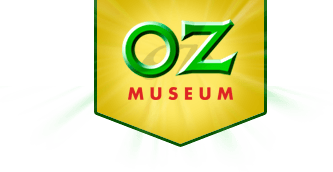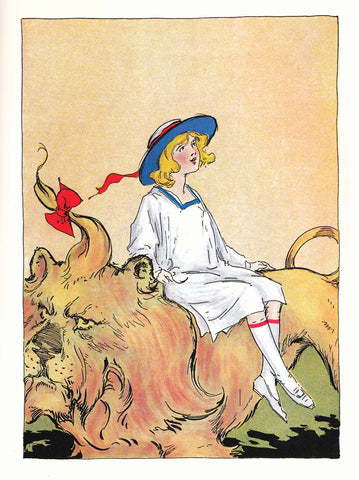 VISIT
MUSEUM STORE
MEMBERSHIP
OZ NEWS
CONTACT
VISIT
MUSEUM STORE
MEMBERSHIP
OZ NEWS
CONTACT
Discovering OZ: The Royal Histories - Magic of OZ
DISCOVERING OZ: THE ROYAL HISTORIES --
HOW MAGICAL IS “THE MAGIC OF OZ”?

[Above: Dorothy and the Cowardly Lion were once again reunited in adventure for the 1919 Oz Book, THE MAGIC OF OZ. Their affectionate regard and partnership had begun, of course, nineteen years earlier in THE WONDERFUL WIZARD OF OZ. The King of the Beasts then went on to companion and protect the little girl in the shared escapades and challenges detailed in OZMA OF OZ (1907) and THE LOST PRINCESS OF OZ (1917).]
Although L. Frank Baum suffered the throes of often serious physical illnesses from 1916-1919, he rose above them whenever possible and didn’t let such “Great Outside World” problems interfere with the joys he continued to share in his writing. Indeed, the author seems to have devoted special energy and imagination to the Oz Books that would be published between 1917-1920. The two blogs just prior to this one offered proof of that in their celebrations of THE LOST PRINCESS OF OZ and THE TIN WOODMAN OF OZ; herein, we continue with extraordinary examples from THE MAGIC OF OZ – his title for 1919.
The increasing sales success of those preceding titles convinced Baum that readers rejoiced in stories that centered on familiar characters within the Land of Oz itself. They also enthused about the occasional new folk or creatures who would bring actual threats or episodes of comedy to Baum’s annual saga. In THE MAGIC OF OZ, he pretty much worked within that template but ambitiously launched three simultaneous tales in the first six chapters.
The first of these narratives is propelled by a discontented, disagreeable misfit of a Munchkin boy, Kiki Aru, who alienates all around him. One day, he literally stumbles on an all-powerful magic word of transformation – written on the underside of a floorboard and hidden there by his father, a former Sorcerer.

The boy quickly grasps the import of such a transcendent mystical tool, turns himself into a hawk, and flies away from his unhappy home. He soon precisely encounters the wrong kind of company in reprehensible old Ruggedo, the former Nome King – long since banished from his own kingdom for relentless bad behavior. The savvy ex-monarch observes Kiki in another (although careless) act of self-transformation; he realizes the boy possesses wondrous power and speedily ingratiates himself into a partnership with the lad. Typically, he immediately proposes that Kiki use his magic to help Ruggedo destroy his perceived enemies and the entire Land of Oz.

Now, to paraphrase the dialog in old movie westerns: “Meanwhile, back at the” Emerald City . . . there’s much excitement attendant to Ozma’s upcoming birthday party. Dorothy is searching for a special idea for her own gift to the Princess and is frustrated to discover that everybody from whom she seeks counsel already has their own presents in hand. (Baum smoothly presents all of this in a happy montage of cameo appearances by “the local legends” – sure to please his readers -- as Dorothy individually confabs with Toto, the Scarecrow, the Patchwork Girl, the Tin Woodman, her pet pink kitten, and Glinda the Good. Ultimately spurred on by Glinda, Dot imagines a special, magical birthday cake, springs the concept on the Wizard (also in search of a gift idea of his own), and off they go together to collect the animals they’ll need to create their joint surprise:

The girl and gentleman are joined in their journey by the Cowardly Lion and Hungry Tiger, who serve as exemplary company, conveyance, and any needed defense against the wild animals in their planned destination: the thick and mostly uncharted Gugu Forest in the Gillikin Country. At the same time, Kiki and Ruggedo are unwittingly headed for the same destination. They’re disguised – thanks to Kiki’s transformation word – as Li-Mon-Eags: composite flying beasts with the wings of eagles, the heads of lions, the bodies of monkeys, and other salient, unique characteristics:
By coincidence, the Li-Mon-Eags arrive at the Forest of Gugu just as Gugu himself (the leopard king) is in session with his primary counselors: Bru the Bear, Rango the Gray Ape, and Loo the Unicorn. The “camouflaged” Nome King – as spokesman for himself and his twin Li-Mon-Eag – offers a massively fabricated story to the four animals: The people of Oz are about to make war on all the citizens of the forest and enslave them. Ruggedo suggests instead that the Li-Mon-Eags help the animals to beat the Ozians to the attack and take over Oz themselves. The shaken Gugu counsel agrees to call all the forest citizenry together the next morning to vote on the matter:

The next morning in the forest clearing, the din of thousands of congregated and conflated animals is constantly interrupted by the nefarious encouragement of the Nome King/Li-Mon-Eag. At the peak of the uproar, who should ride into the middle of the madness but a little girl perched on the back of a massive lion and an elderly man comfortably riding a ginormous tiger:

Our heroine and heroes from the Emerald City calmly introduce themselves, and although some of the gathered assemblage is wary, the celebrities are mostly welcomed by the Gugu citizenry. Two members of the crowd, however, are actually and actively panicking: the Nome King, who despite his disguise, realizes that his plot to furtively overthrow Oz has hit a major obstacle – and especially Kiki. Young and basically inexperienced on every level, he surreptitiously creeps away from the massed throng and – terrified -- whispers the transformation word, changing the Wizard of Oz into a fox. There is instant confusion, during which time the Li-Mon-Eag boy turns Dorothy into a lamb, the Lion into a little Munchkin boy, the Tiger into a bunny, and Gugu into a fat Gillikin woman. When the appalled Ruggedo yells at Kiki to stop, the lad changes him into a goose. Hundreds of Gugu animals instantly scatter at such sights, and five of the transmuted characters are left alone; the sixth – the Nome King goose – has run off to find Kiki and try to effect damage control. (In the picture below, the five are confronted by the Glass Cat from the Emerald City, whose part in the plot will soon be revealed!)

If, as a fox, the Wizard of Oz has temporarily lost his powers, he’s sage enough to creep around the woods until he finds the goose and Li-Mon-Eag. He hides in a hollow tree and soon overhears Kiki pronounce the single word that turns Ruggedo from fowl to foul; the Nome King once again becomes a Li-Mon-Eag. The boy then wreaks magical havoc by turning several Gugu monkeys into giant soldiers – thus and unknowingly permitting the Wizard to hear him speak the transformation charm several times.

The clever magician (ah, those natives of Omaha!) then rises to his full-fledged savoir-faire and uses the word to turn Kiki into a hickory nut and Ruggedo into a walnut. The Wizard next regains his own shape, restores the others to their natural forms, and reestablishes the Gugu monkeys as themselves at their regular size.
Amidst all of the foregoing, leave it to Baum to create a third, counterpoint plotline, which has by now brought grim and life-threatening danger to Trot and Cap’n Bill. The hero and heroine of Baum’s THE SEA FAIRIES, SKY ISLAND, and THE SCARECROW OF OZ became permanent Emerald City residents four books earlier. In THE MAGIC OF OZ -- with the egomaniacal Glass Cat as a guide – they’ve trundled to another far corner of Oz to rescue a Magic Flower from a small island in the middle of a river. They plan this as their natal day honor for Ozma. Once on the island, however, they discover that their feet have taken root in the ground. Not only can they no longer move, but they’ve also begun to precipitously shrink away, with every indication that there’ll soon be nothing left of them.

For all her self-absorption, the Glass Cat always proves to be a friend in need. She tirelessly dashes across many miles of Oz to find the Wizard and his traveling companions, who then journey back to the island with the Cat to see if the little girl and old sailor can be rescued. Yet even the Wizard’s strongest and most potent magical powers, components, and approaches fail . . . until non-magical Dorothy comes up with a plan.
Soon, all of them are on the way home, arriving in time for the beloved and Rightful Ruler’s celebration. Cap’n Bill has even determined a safe means of procuring the Magic Flower from the isle of doom.

Of course, Ozma’s celebration befits her standing as the most magical monarch in fairyland history. John R. Neill – who illustrated the whole of THE MAGIC OF OZ – made his typically consummate achievement of the job, and even though this drawing shows but a small percentage of the honored birthday guests, a well-versed Ozianado will recognize the Princess herself, the Scarecrow, Tin Woodman, Cap’n Bill, Button Bright, and Ojo the Lucky.

Perhaps it’s only fair to tell you that – for all the trouble encountered along the way – the trip made to the Forest of Gugu by Dorothy, the Wizard, the Lion, and the Tiger was most successful. They aligned their idea of a magic birthday cake with “special guest appearances” by some of the monkeys they met there, providing a banquet finale never even imagined by the famous four-and-twenty-blackbirds baked into a pie some decades earlier.

Of course, that’s not all the magic so generously strewn by Baum throughout THE MAGIC OF OZ. You’ll have to read the book to learn about the Lonesome Duck in a Diamond Palace; the fierce Kalidah briefly restrained (and how!) by Cap’n Bill; the theft and retrieval of the Wizard’s Black Bag of Magic Tools; the embarrassing punishment accorded the Glass Cat by the miniature monkeys of Gugu; the fate of the hickory nut and the walnut . . . .

As might be expected, the book’s reviews in 1919 conveyed the customary sagacious appraisals of L. Frank Baum’s efforts and charm. PUBLISHERS’ WEEKLY cited the “more marvelous adventures . . . to delight those omnivorous boy and girl readers who never tire of the wonders of Oz.” In the New York EVENING POST, the critic decided that “this latest addition . . . is no whit less interesting or exciting than the chronicles that have preceded it” and then asked the question, “What child but has played some time at sorcery and has pronounced with all solemnity a magic word that is to transform his companions . . .?”
This thirteenth of Baum’s Oz Book Series appeared during the months approaching Christmas 1919, hitting the market roughly a year after the conclusion of World War 1. This was indeed a boom time for business, and the immediately happy news from Reilly & Lee noted that the book had quickly sold over 26,000 copies.

And – finally. Are you at all interested in that one magic word that can turn anyone into anything – and that started (and, as it turns out) concluded the chronicle of THE MAGIC OF OZ?
The word is . . . P – Y - R – Z – Q – X – G - L.
That’s pronounced . . . PYRZQXGL.
Go ahead.
Try. 😊
(And thank you for being here!)
Article by John Fricke


